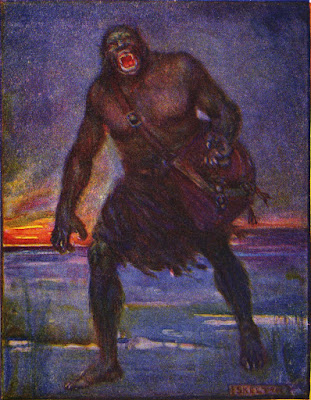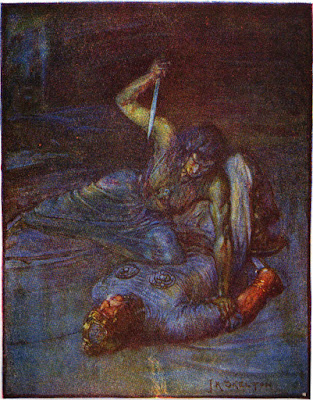Well, January was used up and Monday, February 1st was also taken, so that makes today the first free Monday in 2021 for Monstrous Mondays! Let's get to it.
First I want to talk a little bit about my two monster books, the Basic Bestiaries. I am far behind my original and revised, release dates. Not that this is a big deal really save that I wanted to something more done. I mentioned a while back that I began with one book and I am now splitting it up into two books, one for witch and witchcraft associated monsters and another for various demons and devils. Work has continued on both books, but I might get to a point where I need to split them up yet again. No big details yet, but I have an overabundance of the undead, in particular, vampires. Still, my choice is two books and I am extremely happy with my Fuseli and Goya covers.
This brings me to today's post. The Yaoguai and Chinese demons.
My demons are now over 500 individual monsters and I am just getting started. I have talked a lot about demons here.
What I know about Chinese Mythology could fill a book. A very small, poorly edited book.
Here is what I have learned over the last few months.
Yaoguai are a class of mostly evil (but not always so) spirits. The name is used for the collection of all such spirits and for a group of specific animal spirits. The name comes from the characters 妖怪 which translate into "strange ghost." They are related to yaomo (妖魔 yāomó, lit. "strange devil") or yaojing (妖精 yāojīng, lit. "sprite" or "seductive") all start with the same character 妖. This (typically) refers to an awakened spirit.
And as expected it also far more complicated than that. Though as I have mentioned before, I can't serve two masters, in this case, Chinese mythology and good Game Design.
Yaoguai
Lesser Yaoguai are all animal spirits that were normally benign but have sought out immortality by becoming demons. While they can generally be described as evil, they are often more selfish and amoral. The ones most encountered are evil since they tend to work against mortals.
All lesser yaoguai can be recognized by their glowing eyes, preternatural strength, and enlarged teeth and claws. All yaoguai can speak common and any other local languages.
As a spirit creature, a lesser yaoguai can be "Turned" by a cleric as if they were undead. They do need to know their proper name. So "begone rat demon" will not work, but "begone shǔ yaoguai" will. A result of "T" will cause the creature to run away. A "D" result will force the spirit out of the animal in question, often killing the host animal.
Lesser Yaoguai also all have the following powers.
- Spirit. The natural form of the Yaoguai is a spirit. It will inhabit the body, living or dead, of the animal of their type.
- Command Animals. Lesser Yaoguai can command animals of the same type. Niú Yaoguai can command oxen and other cattle for example.
- Hybrid form. Yaoguai can shift between animal form and a humanoid form like a lycanthrope.
- Immune to poison, gas, polymorph, and petrify effects. Immune to normal weapons.
- Half damage from cold, fire, and electricity effects. Half damage from silver weapons.
- Full damage from magical weapons.
- Double damage from a blessed weapon. These weapons specifically blessed by a priest to fight a particular type of Yaoguai spirit.
Shǔ Yaoguai
Rat demon spirit
Medium Fiend (Demonic, Yaoguai)
Frequency: Uncommon
Number Appearing: 1 (1)
Alignment: Chaotic [Chaotic Evil]
Movement: 120' (40') [12"]
Hybrid: 120' (40') [12"]
Spirit: 240' (80') [24"]
Armor Class: 6 [13]
Hit Dice: 5d8***+5 (28hp)
Attacks: claw/claw, bite
Damage: 2d4+1 x2, 1d6+1
Special: disease (demon fever), summon animals
Size: Medium
Save: Monster 5
Morale: 8 (NA)
Treasure Hoard Class: None
XP: 750 (OSE) 860 (LL)
Shǔ Yaoguai, or Rat demon spirit, is the most common of the lesser yaoguai encountered. They appear as large rats with glowing eyes and human intelligence. In fact, they are often smarter than humans. They can be found wherever large groups of rats are found. They are often mistaken for wererats or dire rats of a, particularly evil mien.
Shǔ Yaoguai can attack with claw and bite and it is by these means that they deliver their curse of Demon Fever. On a successful critical hit with a bite (a natural 20 rolled), they transmit Demon Fever.
The subject is allowed a saving throw vs poison. A fail means death, a successful save means the victim has contracted a slower version of the fever. They will not be able to do anything but require complete bed rest. They will lose one Constitution point per day unless a Cure Disease is cast on them. If they reach o Constitution they will die.
These demons can summon 10-100 normal rats, 2-40 dire rats, or 1-6 wererats in rat form.
Rat demons exist to cause chaos and suffering only. While they are intelligent their plans typically do not exist beyond this.
Niú Yaoguai
Ox demon spirit
Medium Fiend (Demonic, Yaoguai)
Frequency: Rare
Number Appearing: 1 (1)
Alignment: Chaotic [Chaotic Evil]
Movement: 90' (30') [9"]
Hybrid: 120' (40') [12"]
Spirit: 240' (80') [24"]
Armor Class: 5 [14]
Hit Dice: 7d8**+21 (53hp)
Attacks: I headbutt
Damage: 2d8+3
Special: Trample (4d8+3)
Size: Medium
Save: Monster 7
Morale: 10 (NA)
Treasure Hoard Class: XV [H]
XP: 1,250 (OSE) 1,200 (LL)
Niú Yaoguai, or Ox demon spirit, are among the least intelligent of the yaoguai. They are also among the strongest and the greediest. In their animal form, they appear as a black and red ox with fiery eyes. Their hybrid human form appears as a minotaur.
The main attack of the ox demon is a running headbutt. On any critical hit (a natural 20) they also knock their opponent prone and trample them as an automatic attack. The prone victim needs 1 combat round to get back on their feet. The ox demon is not very dexterous and needs a full round to turn around if they wish to attack the same victim twice.
These demons are slow, dumb, and very materialistic. They can also be bribed with treasure; at least double or triple what their current treasure hoard is worth (discounting magic items which they have value for). If this offer is made even the chaotic ox demon will not attack.
Hǔ Yaoguai
Tiger demon spirit
Medium Fiend (Demonic, Yaoguai)
Frequency: Rare
Number Appearing: 1 (1)
Alignment: Chaotic [Chaotic Evil]
Movement: 120' (40') [12"]
Hybrid: 120' (40') [12"]
Spirit: 240' (80') [24"]
Armor Class: 6[13]
Hit Dice: 9d8**+9 (50hp)
Attacks: claw/claw, bite
Damage: 1d6+2 x2, 2d8+1
Special: rake (back legs for 1d8+2 x2)
Size: Medium
Save: Monster 9
Morale: 10 (NA)
Treasure Hoard Class: XXII [A]
XP: 2,350 (OSE) 2,400 (LL)
Hǔ Yaoguai or Tiger demon spirit are among the most violent of all the yaoguai. They appear as tigers with glowing eyes. Their hybrid form reminds one of a weretiger or even a type of Rakshasa; a comparison that both types of fiends abhor.
The tiger demon gleefully attacks with its claws and bite. A critical hit on a bite attack (natural 20) will result in a pin and the demon can then attack with its hind legs for a rake. A hǔ yaoguai in hybrid form cannot rake.
This demon delights in sowing fear. Its preferred attack is to seek out remote villages and begin to kill lone travelers. It will leave the bodies where they can be found to raise the fear levels. Its ultimate goal is to not just kill as many mortals as it can, but also to get the inhabitants of a village or local so scarred that normal life stops. Fields are not attended, work ceases in other parts of the village, and so on. Killing a handful of villagers with claw and bite is satisfying. Killing dozens because there are now not enough crops to feed them is a greater evil.
Despite their propensity to violence they are a clever demon and will work towards the maximum fear they can.
Shé Yaoguai
Serpent demon spirit
Medium Fiend (Demonic, Yaoguai)
Frequency: Rare
Number Appearing: 1 (1)
Alignment: Chaotic [Chaotic Evil]
Movement: 150' (50') [15"]
Hybrid: 120' (40') [12"]
Spirit: 240' (80') [24"]
Armor Class: 5 [14]
Hit Dice: 8d8***+16 (52hp)
Attacks: bite + poison
Damage: 1d6, save vs. poison
Special: Poison, summon normal animals
Size: Medium
Save: Monster 8
Morale: 10 (NA)
Treasure Hoard Class: XX [C]
XP: 2,300 (OSE) 2,440 (LL)
Of all the lesser yaoguai the Shé Yaoguai, or Serpent demon spirit, is the most clever. Second only to the Hóu Yaoguai; but never mention that to these evil creatures. They spend the most time in their animal form as a large constrictor snake with glowing eyes, large fangs, and strange markings on their skin. They are never confused with normal snakes. Their hybrid form is that of a large snake with a humanoid torso and arms with a snake's head.
This yaoguai prefers to attack with its bite only. A critical hit (natural 20) means they have injected a paralytic poison into their victim. The victim needs to save vs. poison or die. A successful save still infects the victim and they lose 1 point of Dexterity per round. This will affect any attack or armor class of the victim. When they reach 0 Dexterity they are paralyzed permanently unless a Remove or Neutralize Poison spell is cast. If all their victims are defeated then the serpent demon will feast on the corpses and the paralyzed.
Shé yaogaui demons can also summon 10-100 normal snakes, 1-10 poisonous vipers, and 1-10 constrictor snakes.
Among the most evil of these types of demons the Serpent Yaoguai attempt to tempt humans into hedonistic lifestyles where only their own pleasures matter. To this end, they work through others to provide decadent parties, banquets, and houses of pleasure.
Hóu Yaoguai
Monkey demon spirit
Medium Fiend (Demonic, Yaoguai)
Frequency: Very Rare
Number Appearing: 1 (1)
Alignment: Chaotic [Chaotic Evil]
Movement: 120' (40') [12"]
Hybrid: 120' (40') [12"]
Spirit: 240' (80') [24"]
Armor Class: 6 [13]
Hit Dice: 10d8***+10 (55hp)
Attacks: claw/claw, bite
Damage: 1d4+1 x2, 1d6+1
Special: Yaoguai abilities
Size: Medium
Save: Monster 10
Morale: 10 (NA)
Treasure Hoard Class: XXI [B]
XP: 3,000 (OSE) 3,100 (LL)
Hóu Yaoguai, or Monkey demon spirit, are among the most powerful, smartest, and evil of the lesser Yaoguai. Their animal form is that of a particularly evil-looking monkey looking like a macaque combined with a chimpanzee. In their hybrid form, they can pass for a hairy human. Given the proper clothing, they can be 90% indistinguishable.
Like all yaoguai, these creatures prefer to attack with their natural weapons. In this case two claws and a bite. Unlike others, there is no special attack by this demon.
These demons are more subtle than their kindred. There are no summonings of creatures or deadly diseases. What they can do is summon 2-20 thralls; mercenary humans they have brought over to their causes. This suits the Hóu Yaoguai well in its chosen area of interest. The breakup of human-run governments.
The Hóu Yaoguai will insert itself into a government as a low-level official and work its way up to power where it can influence governors, princes, or even the Emporer. Its goal is always the same bring as much chaos as it can. The ultimate goal for any Monkey demon is civil war.
--
Not too bad for a start.




























